- DETERRENCE: A Time-Lapse Map of Every Nuclear Explosion Since 1945
- DPRK: The Korean War and Sino-North Korean Friendship
- ENERGY SECURITY: Timing a rise in sea level
- GOVERNANCE AND CIVIL SOCIETY: Ban lifted, Japan’s politicians race online
- CLIMATE CHANGE ADAPTATION: Costs and Coasts: An Empirical Assessment of Physical and Institutional Climate Adaptation Pathways
- CLIMATE CHANGE AND SECURITY: Icelandic academics warn independent Scotland would be at ‘deep strategic disadvantage’
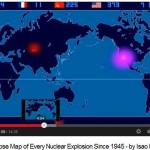 DETERRENCE: A Time-Lapse Map of Every Nuclear Explosion Since 1945, Isao Hashimoto, October 24, 2010
DETERRENCE: A Time-Lapse Map of Every Nuclear Explosion Since 1945, Isao Hashimoto, October 24, 2010
Hashimoto’s time-lapse video map shows 2053 nuclear explosions between 1945 and 1998 in 14.25 minutes, 1 month/second. The artist aimed to express “the fear and the folly of nuclear weapons.” “I created this work for the means of an interface to the people who are yet to know of the extremely grave, but present problem of the world.”
- The Century with Mushroom Clouds: Project for the 20th Century, Beauty in the Face of Destruction: a Chinese Artist Growing Up in the Cold War Era, Megan Hennessy Smith, Bachelor of Arts thesis, Texas Christian University, Fort Worth, Texas, 2007 [PDF 2.1MB, Proquest Dissertations subscription required]
- NUKEMAP 3D: The Next Generation of Do-It-Yourself Nuclear War, A nuclear weapons effects simulator for Google Earth, Alex Wellerstein, 2013
- Live US nuclear warhead test and explosion Frigate Bird, May 6, 1962 via Polaris A2 missile test fired from USS Ethan Allen SSBN 608, at 1.30 minutes
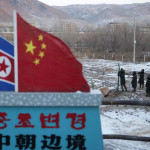 DPRK: The Korean War and Sino-North Korean Friendship, Heonik Kwon, The Asia-Pacific Journal, Volume 11, Issue 32, No. 4Global Security Newswire, (12 August 2013)
DPRK: The Korean War and Sino-North Korean Friendship, Heonik Kwon, The Asia-Pacific Journal, Volume 11, Issue 32, No. 4Global Security Newswire, (12 August 2013)
North Korea’s relationship with China can be interpreted several different ways. What is clear and constant is that the mutual relationship is always subordinate to respective domestic issues. Perhaps China’s debate is especially high volume as they try indirectly to influence China’s first Beidaihe leadership meeting since new President Xi Jinping assumed his decadal position as Paramount Leader.
- China and Korea: a change of partners, Aidan Foster-Carter, Asia Times on-line (7 August 2013)
- Shan Renping: It is unkind to attack North Korea so obliquely, Shan Renping, Global Times Opinion (13 August 2013) [Chinese language]
- Chen Guangwen: North Korea conducts its own significant disarmament on the peninsula, Chen Guangwen, Global Times Opinion (11 July 2013)
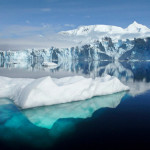 ENERGY SECURITY: Timing a rise in sea level, Justin Gillis, New York Times [13 August 2013]
ENERGY SECURITY: Timing a rise in sea level, Justin Gillis, New York Times [13 August 2013]
Model scenarios show sea-level rise of one 1 foot up to 4 to 6 feet by 2100 and 23 feet “over the long term”, a catastrophe blamed, for the most part (but not which part and how much of the blame) on fossil fuel CO2 emissions. A theology of apocalypse is easy to propagate when apocalypse now can be ignored. NRC review of draft US National Climate Assessment wisely suggests clarifying uncertainties and avoiding speculations.
- Global Sea Level Rise Scenarios for the United States National Climate Assessment, National Oceanic and Atmospheric Administration, US Geological Survey, SERDP (Department of Defense, Environmental Protection Agency, Department of Energy), US Army Corps of Engineers. NOAA Technical Report OAR CPO-1 [6 December 2012]
- Draft United States National Climate Assessment (11 January 2013 version for public comment; comment period now closed)
- A review of the draft 2013 National Climate Assessment, National Research Council of the National Academies. [April 2013]
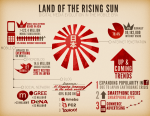 GOVERNANCE AND CIVIL SOCIETY: Ban lifted, Japan’s politicians race online, Hiroko Tabuchi, New York Times (4 July 2013)
GOVERNANCE AND CIVIL SOCIETY: Ban lifted, Japan’s politicians race online, Hiroko Tabuchi, New York Times (4 July 2013)
Social networking has reshaped diplomacy and governance, bridging gaps between governments, NGOs and citizens. Politicians utilized social media for the first time in Japan’s recent elections and users throughout Asia, as around the globe, are turning to social media to express dissatisfaction with the status quo—but with a bit of censorship. Some interesting connections are seen when looking at the Twitter use of diplomats and countries.
- Cambodia’s young show courage, desire for change, Kounila Keo, Bangkok Post (1 August 2013)
- Social media hasn’t weakened censorship in China, Matt Schiavenza, The Atlantic (16 July 2013)
- Drawing the social network of digital diplomats, Joe Mitchell (7 December 2012)
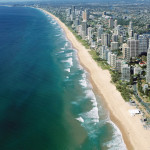 CLIMATE CHANGE ADAPTATION: Costs and Coasts: An Empirical Assessment of Physical and Institutional Climate Adaptation Pathways, CS Fletcher et al., CSIRO Climate Adaptation Flagship, CSIRO and National Climate Change Adaptation Research Facility – NCCARF (2013) [2.05 MB, PDF]
CLIMATE CHANGE ADAPTATION: Costs and Coasts: An Empirical Assessment of Physical and Institutional Climate Adaptation Pathways, CS Fletcher et al., CSIRO Climate Adaptation Flagship, CSIRO and National Climate Change Adaptation Research Facility – NCCARF (2013) [2.05 MB, PDF]
In any given coastal community there may be a range of adaptation options that can ameliorate some or all of the effects of future coastal inundation events by ‘protecting’ against inundation (e.g. seawalls), redesigning infrastructure to ‘accommodate’ inundation (e.g. raised floor heights), or ‘retreating’ out of areas likely to be inundated. Often, a suite of adaptations may be necessary to meet all community goals and expectations.
- Sea Level Rise: Understanding The Past – Improving Projections For The Future, Commonwealth Scientific and Industrial Research Organisation-CSIRO (2013)
- Managed Retreat of Coastal Communities: Understanding Responses To Projected Sea Level Rise, Journal of Environmental Planning and Management, vol. 55, pp. 409-433 (2012) [subscription required]
 CLIMATE CHANGE AND SECURITY: Icelandic academics warn independent Scotland would be at ‘deep strategic disadvantage’, HeraldScotland (29 July 2013)
CLIMATE CHANGE AND SECURITY: Icelandic academics warn independent Scotland would be at ‘deep strategic disadvantage’, HeraldScotland (29 July 2013)
An independent Scotland would be at a deep strategic disadvantage to Russia in the conflict that is expected to emerge from climate change, and would need shelter from stronger allies. While the US does not want an independent Scotland, the five Nordics have lived for decades with the same strategic asymmetry that would face Scotland.
- Scotland as an Independent Small State: Where would it seek shelter? Alyson JK Bailes, Baldur Thorhallsson and Rachael Lorna Johnstone, Stjórnmál & stjórnsýsla: Icelandic Review of Politics and Administration, vol. 9, issue 1
- Will global warming lead to more war? It’s not that simple, Brad Plumer, wonkblog, Washington Post, (5 August 2013)
- World food security more vulnerable than ever to climate change, Phys.org (2 August 2013)
The Nautilus Peace and Security Weekly Report presents articles and full length reports each week in six categories: Austral security, nuclear deterrence, energy security, climate change and security, the DPRK, climate change adaptation and governance and civil society. Our team of contributors carefully select items that highlight the links between these themes and the three regions in which our offices are found—North America, Northeast Asia, and the Austral-Asia region.
Subscribe to NAPSNet to receive free weekly email reports
Editor
- Saegan Swanson (while Arabella Imhoff is on leave)
Contributors
- Deterrence: Peter Hayes
- Governance and Civil Society: Dyana Mardon
- Climate Change Adaptation: Saleem Janjua
- DPRK: Roger Cavazos
- Energy Security: Nikhil Desai
- Climate Change and Security: Richard Tanter

